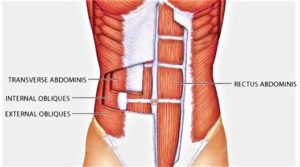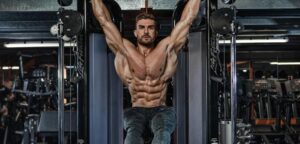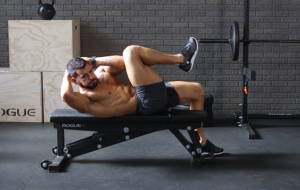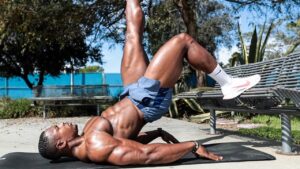Abdominals are the sexiest of all muscles. Centrally located, they’re the bling of a physique that proves their owner put in the gym and diet work. That sexiness is why, for such a simple set of muscles with such a simple role—stabilizing the torso and bending it slightly forward and to the sides—there are an outrageous number of exercises, devices, and exercise variations, not to mention all the instructions, routines, and courses, forever promising to make it easy. There’s a whole ab industry.
So, what to make of it all? What works best and what doesn’t work at all? Researchers have studied this question by determining exactly how much the abs are activated during various exercises with various equipment. We’ve reviewed the studies—and there are a lot of them. Now, we reveal the best, the worst, and the pretty good ab exercises.
Abs Anatomy

• Rectus Abdominis is the front wall of the banded muscle. (Fun fact: The number of bands varies by genetics, so not everyone has a six-pack of three upper bands on each side.) The main function of the rectus abs is to move your ribcage towards your pelvis. Though the rectus abs are all one muscle (technically, two: left and right), they are frequently divided to upper and lower in regards to exercises.
• Obliques (exterior and interior) are on the sides of your abdomen; the exterior attaches higher than the interior. Obliques work with the rectus abs to move your ribcage towards your pelvis, but their primary function is bending your torso towards one side or the other and rotating your torso.
• Transverse Abdominis is a thin, flat sheet of muscle that lies beneath the rectus abs and obliques. It works to stabilize the torso and pull your midsection in.
The Studies
Abdominal exercises have been researched a lot. The results can be confusing with sometimes conflicting studies. This is mostly because, with the small range of motion of the abs, form is crucial to maximally activate the muscles. Also, different electromyography (EMG) tests—which measure muscle activity via electrodes and a machine—focus on different exercises. We reviewed all of these studies and narrowed our principal focus to four:
• EMG study 1: The American Council of Exercise, 2014, 16 men and women, 15 ab exercises
One exercise ranked highest for both upper and lower rectus abs (and second-highest for obliques): incline curl-up. Second best for upper and lower abs: stability ball crunch, but vertical leg raise (both hanging and captain’s chair) virtually tied it for lower ab activation.
• EMG study 2: The American Council on Exercise, 2001, 30 men and women, 13 ab exercises
Two exercises ranked far above the others for both rectus ab and oblique activation: vertical leg raise (captain’s chair) and bicycle crunch. Third for rectus abs: stability ball crunch. This study didn’t distinguish between upper and lower abs.
• EMG study 3: Boeckh-Behrens & Buskies, 2000, 10 men, 12 ab exercises
The crunch (with arms extended) ranked highest for upper abs, the vertical leg raise (hanging) ranked highest for lower abs, and the bicycle crunch ranked high for lower and upper abs. The side bend was tops for obliques.
• EMG study 4: Rafael F Escamilla, etc., 2006, 21 men & women, 12 ab exercises
The incline curl-up (called “incline reverse crunch”) ranked best for upper abs. The roll-out (with Power Wheel) nearly tied it, and was best for lower abs and second-best for external obliques. Second for lower abs: vertical leg raise (hanging). Best for obliques: pike (with a Power Wheel).
The Best
The Vertical Leg Raise
Whether performed hanging with arm straps or in a captain’s chair with your forearms balanced on pads, leg raises with your upper body vertical was the only exercise to rank high in all four studies—though, other than the crunch, it was the only exercise in all four. (For good measure, here’s EMG study 5 that ranked it the highest for rectus abs of any ab exercise.) You can also do these while simply gripping an overhead bar, though this will involve the lats more and your grip may be the weak link.
✅ The important thing is to raise your feet as high as possible (ideally, shoulder-level) so that your butt comes up and your spine curls forward. Doing it in this way, without swinging, maximally activates your abs. (It’s also contrary to much “expert advice,” which incorrectly tells you to always keep your torso rigidly horizontal.)
✅ The straighter (and longer) your legs are, the greater the resistance. Keep your legs bent until you’re strong enough to use straight legs. You can also start with straight legs and switch to bent legs when you fatigue.

Incline Curl-Up
Also called: incline reverse crunch or decline bench curl-up. This was a winner in the two studies that included it. It ranked highest for both upper abs and lower abs and very good for obliques in study 1 and highest for upper abs in study 4. The curl-up is sort of a combination of a knee raise and a crunch. Just as we preached curling your spine up during the vertical leg raise, this is all about that.
✅ Lie face-up on a decline bench with your head near the top. Grip the support or pads behind your head. Start with your knees bent. Raise your legs, butt, and back up while contracting your abs and curling your torso. At the top, your knees should be near or between your elbows, and your thighs should be approximately parallel to the floor.
✅ If you get fatigued, shorten the range of motion, turning this into more of a knee raise, but continue focusing on maximal contractions on each rep.
Bicycle Crunch
The bicycle crunch ranked high in the two earlier studies, but only okay in the most recent one. That may be because the rhythmic form is somewhat difficult to maintain. This combines a crunch with a leg lift with a twisting motion.
✅ Lie on the floor with your hands behind your head and legs straight and, if you can, held a few inches off the floor. Raise one knee towards your chest, and simultaneously raise your torso and twist so the opposite elbow comes towards the raised knee. On the next rep, raise the other knee and twist so the other elbow comes towards it.
✅ Resist the temptation to go fast. Instead, focus on a maximal abdominal contraction on each rep.

Roll-Out
This one narrowly beat out the stability ball crunch. The roll-out ranked at or near the top for lower and upper abs in study 4 with a Power Wheel as well as in EMG study 6 with a Swiss ball. And it provides some variety from the previous crunching movements, working your delts and back with your abs.
✅ You can do this with various equipment: a roller, an exercise ball, a weighted barbell. Whichever you use, kneel down, grab the “roller,” extend so your torso is parallel to and just above the floor (roll-out), and return to the starting position (roll-in). Shorten your reps when you grow fatigued, or if you’re not yet strong enough to do fully extended reps.
✅ The key is keeping your back flat and your abs contracted throughout each rep. Don’t let your middle sag, because you’ll lose tension on your abs and potentially strain your spinal erectors.
The worst
SIT-UP The sit-up was only included in study 4, and it did not fair well. But then the verdict was already in the last century, and it keeps coming in, again and again, and again. The sit-up involves the hip flexors too much and just isn’t a very effective ab exercise. The same can be said for sit-up variations, like decline sit-ups, Roman chair sit-ups, etc.
RESISTANCE BAND CRUNCH (a.k.a. exercise tubing pull) This is a crunch while holding a band or tubing behind or above your head. We suspect this exercise—which increases tension the more you contract but can lose it quickly afterwards—is difficult to do in a manner that sustains great ab activation.
AB ROCKER, AB CIRCLE PRO, and AB REVOLUTIONIZER. Step right up, and behold the miracle gadgets! Guaranteed to melt away fat and sculpt in abs! Or so the infomercials promised. Several devices were tested in studies 1, 2 & 5. These three rated: garbage. None seem to be in production anymore, but if you’re tempted to grab one on eBay, don’t.
BROOMSTICK TWIST This old-school “waist trimmer” ranked the worst of any supposed ab exercise tested. With virtually no resistance, twisting can stretch your core, but it’s not adding oblique muscle or subtracting fat.
The Rest
The STABILITY BALL CRUNCH, a top-five ab exercise, ranked high in the two studies (1 & 2) in which it was included. Arching your back on a ball provides for a longer range of motion than a traditional crunch. Keeping your arms straight or nearly so in the over-the-head position provides greater resistance than arms folded on your chest. Hands behind your head, but not pulling your head forward, is a good compromise between the two.
The SIDE BEND ranked #1 for obliques by a wide margin in study 3, the only one in which it was included. However, we don’t have data to see how it stacks up against other oblique-specific exercises, like the cable woodchopper, twisting leg raise, and machine twists. We suspect they all would rank high. Each of our four best exercises do a good job of stressing obliques in addition to rectus abs, so you don’t have to include oblique-specific exercises in our routine. But, if you want to, we recommend the cable side bend or cable woodchopper.
The good old bodyweight CRUNCH ranked highest for upper abs in study 3. Interestingly, it ranked very low in study 2 but high in study 1 for upper and lower abs, 13 years later and sponsored by the same organization. The lead researcher of the latter study explained that the difference was probably due to form, which is crucial for crunching: “I think a part of it is, when we looked at the EMG for the traditional crunch, we had people do the traditional crunch very deliberately and correctly, and I think we had fairly high activation from the abs because of that.” He also said there was no difference in ab activation between arms-folded-across-chest and hands-behind-head. By the way, we would like to see the rope crunch and machine crunch—two popular gym exercises—in a future EMG ab study.
Though the PIKE did not fair well in study 4 with a Power Wheel, it took top honors for lower abs and obliques in study 6 with a Swiss ball. So, it may be all about your equipment choice.
Not all devices are bad. PERFECT SITUP rated high for upper abs and obliques. But didn’t we just say sit-ups suck? Well, this isn’t a sit-up. It basically combines a bicycle crunch and a lying leg raise and adds neck support. But you’ll have to get it on eBay. Maybe they should’ve named it Perfect Crunch. The AB COASTER MAX is still in production, and it did great for obliques and okay for rectus abs. But if your gym doesn’t have this machine, one will cost you $250. The AB ROLLER ranked okay in both studies that tested it, and the POWER WHEEL (ab roller with foot stirrups) ranked very high for roll-outs in study 4 and best for obliques in study 1. You can get an ab roller for under $20 or Power Wheel for under $50.
The PLANK did a poor job of stressing rectus abs or obliques in the two studies that focused on it. However, the lead researcher in Study 1 said: “The plank exercise effectively engages the transverse abdominis, which plays an important role in spinal stabilization.” So, there is a reason to include it in your routine, at least on occasion. Likewise, in study 1, the SIDE PLANK was last, by wide margins, for not just upper and lower abs, but also obliques—the reason for doing them. In study 3, it ranked well for obliques, but the vertical leg raise still tied it. Do side planks for core stability and, with upper arm raised, stretching, but it’s a subpar ab exercise.
The Routine
We’ve assembled the four best exercises into a routine. None are oblique-specific, but if you want to include an oblique exercise like cable side bends or cable woodchoppers, swap one in for one of these.
- Incline Curl-Up 3 x 15 reps
- Vertical Leg Raise 3 x 15 reps
- Roll-out 3 x 15 reps
- Bicycle Crunch 3 x 15 reps
Related: Science Says: The Best (and Worst) Biceps Exercises and Science Says: The Best (and Worst) Triceps Exercises and Science Says: The Best (and Worst) Chest Exercises







